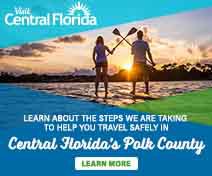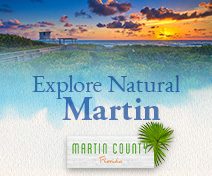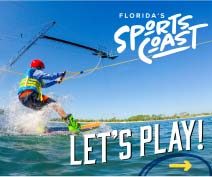WELCOME TO FLORIDA

Embark on Your Florida Journey
The Sunshine State has attracted visitors to its sandy shores for the past 500 years. But go back earlier. Records indicate people first reached Florida at least 12,000 years ago. The coastline was very different then because the sea level was much lower than it is today. As a result, the Florida peninsula was more than twice its current size. Florida has exerted a magnetic pull on a number of visitors for centuries—beginning with the Spanish explorer and adventurer, Juan Ponce de León who landed on this sunny shoreline in 1513.
Although many Native American peoples already lived here, Ponce de León named what he saw “La Florida,” or “place of flowers,” because of the lush landscape. Indeed, Florida has 300 native plants, ranging from the thorny sweet acacia to the wild azalea.
The state also hosts an additional 1,300-plus introduced exotics, including some that were naturally brought into the environment and are considered harmless and others that are invasive. Botanical gardens, such as the renowned Fairchild Tropical Botanic Garden and the Central Florida Zoo and Botanical Gardens, are excellent places to learn about the state’s oft-bizarre vegetative life.
A Bountiful Land
The state flower is the orange blossom, which is considered an exotic, albeit one that became extremely important to the region’s economy. Native to Southeast Asia, the orange tree is an evergreen shrub brought to the colony of St. Augustine in 1565. The orange and its aromatic blossom, which represents fertility and good fortune, quickly became representative of the area. Many towns such as Davie have Orange Blossom Festivals. Florida is among the largest producer of oranges in the U.S. Honey production, and ranks as the fourth largest producer in the country. In 1763 English settlers introduced the first hives in Pensacola, and it’s been sweet ever since.
In fact, Florida depends on export crops as diverse as sugar cane and tomatoes while still leaving plenty of sweet corn and green beans available for passersby to purchase. Visitors are often amazed to find farm stands and U-pick farms offering everything from boiled peanuts and fresh blueberries in Gainesville to mangoes and lychees in the southern areas of Redland and Homestead. Throughout the year, festivals—such as Plant City’s Florida Strawberry Festival in March and the July Mango Days of Summer festival at Fairchild Tropical Botanic Garden in Coral Gables—are hugely enjoyable, multi-day attractions.
If you prefer bottled fruit, wineries are popping up everywhere, with many offering both grape varietals as well as tropical fruit vintages.
Into The Wild
Florida is home to several hundred commonly found bird species, which amateur ornithologists can track along The Great Florida Birding & Wildlife Trail. The 2,000-mile trail comprises four sections—the Panhandle, East, West and South—and lists what species can be found where.
Florida also has more than 170 native butterflies. In addition to finding them in the parks and in the wild, visitors can observe them in conservatories such as Butterfly World in Coconut Creek and the Butterfly Rainforest at the Florida Museum in Gainesville.
The 142 native species of amphibians and reptiles, including around 50 kinds of snakes—of which only six are poisonous—are equally fascinating. You can view these and the 50 plus additional non-native species at many zoos and safaris, ranging from Zoo Miami to Lion Country Safari in Loxahatchee and ZooTampa at Lowry Park.
Visitors who prefer to check out natural habitats where wild things reside can hit any section of the sprawling Everglades. A range of activities from boating and fishing to biking and hiking puts one in close touch with nature’s biggest beasts and smallest insects. The curious can also arrange private tours with exotic animal rescue and rehabilitation operations such as the Zoological Wildlife Foundation and McCarthy’s Wildlife Sanctuary, both located in South Florida.
For conservancy on a smaller scale, many programs all over the state, such as the Museum of Discovery and Science in Fort Lauderdale, help protect sea turtle nests.
Gator Alert
Wild About Florida
Florida is made up of 1,197 miles of coastline, of which 663 are foot-friendly beaches. It isn’t all salty water and fruity cocktail culture, however. The interior of the state is far different than many expect, with nearly 8,000 lakes and more than 11,000 miles of rivers and streams. Lake Okeechobee—in the center of the state—is Florida’s largest. It not only provides drinking water for many surrounding and southern counties, but it is also an agricultural resource for the state’s abundant produce. It offers some of the best largemouth bass fishing in Florida. The protective dike that encircles the lake is part of the National Scenic Trail, a 110-mile route, popular with hikers, naturalists, cyclists and horseback riders.
In addition, the state has nearly 30 first-magnitude freshwater springs—more than any other state. Most of these watering holes, including Wakulla Springs—one of the deepest, and Silver Springs—one of the largest, are clustered in Northwest and North Central Florida.
Finally, Florida claims quite a river culture, notwithstanding the famed River of Grass, a.k.a. the Everglades, where native and non-native wildlife are the most diverse. If you’re lucky, you’ll spot the elusive and endangered Florida panther, the only big cat living in the wild in this state.
From airboat rides and alligator spotting in the swamps to kayaking along the immortal Suwannee River, framed by cool, green woodlands, and crabbing in the tributaries of the Apalachicola River, waterway adventures are endless. Here is also where you’ll find wild hog, which acclimated after the Spanish brought over their native pigs 500 years ago.
Beyond the rivers and lakes, bodies of water on either shore of the Florida peninsula offer deep-sea fishing and diving opportunities galore.
Hit The Beach
Blessed with climates ranging from subtropical in the north to tropical in the coastal and southern regions, Florida is known as the “Sunshine State.” Temperatures average a balmy 70ºF daily, with highs usually peaking in the 90s in July and August. And while the lowest temperature ever recorded in the winter of 1899 was –2ºF in Tallahassee, the normal lows, which last only a couple of days, hover around the 40s or 50s during January or February. Although Florida has its share of inclement weather, it’s renowned for being the warmest state in the U.S. mainland.
The currents of Key Biscayne and the coastal areas around Fort Myers, particularly Sanibel and Captiva islands, are perfect for learning the rudiments of paddleboarding, ocean kayaking and other water sports. For shell hunters, the Gulf Coast, from Fort Myers to Sarasota, is where to go.
Great Savings
The Entertainment Book (shop.entertainment.com) is a local favorite and you don’t have to be a local to buy it. Also try groupon.com or livingsocial.com for discounts at hotels, attractions and restaurants. Three popular attractions in South Florida—Lion Country Safari, Everglades Alligator Farm and Zoo Miami—offer unlimited visits at summersavingspass.com.
In the Tampa Bay area, CityPASS offers savings of 54 percent on admission to the top five Tampa Bay attractions: Busch Gardens Tampa Bay, The Florida Aquarium, ZooTampa at Lowry Park, Clearwater Marine Aquarium and the Museum of Science & Industry or the Tropics Boat Tours Dolphin or Sunset Cruise. The pass is good for 9 consecutive days starting with the first day of use. Plan your visit at citypass.com/tampa.
Family Explorations
Resorts and attractions are an inescapable part of Florida’s identity and some are destinations in their own right.
Head south to the 173,000-acre, mostly underwater, Biscayne National Park where all sorts of outdoor activities are available together with snorkeling, diving and glass-bottom boat tours. It is certainly worth renting a watercraft to search the islands for evidence of early Indigenous groups, to explore shipwrecks and to drift above the coral reef system, where more than 200 species of fish thrive.
Popular water parks in Southeast Florida include Rapids Water Park in Palm Beach County and Broward County’s collection of child-pleasing soakers: Paradise Cove Water Park at C.B. Smith Park, Splash Adventure Water Park at Quiet Waters Park, Castaway Island Water Park at Topeekeegee Yugnee Park, and Tropical Splash Water Park at Central Broward Regional Park.
Water parks, such as Shipwreck Island Waterpark in Panama City Beach and Adventure Island in Tampa, offer thrilling experiences for the whole family, and are especially refreshing in the summertime when the air can be quite humid.










